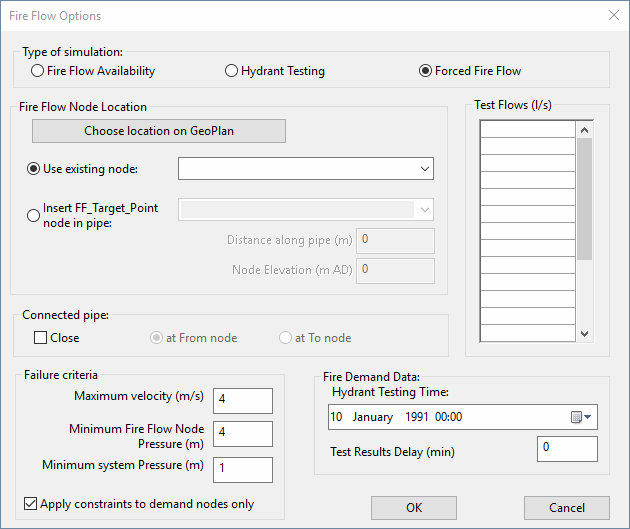Fire Flow Options dialog - Forced Fire Flow view
This dialog view lets you set up a forced fire flow simulation to test a selection of flows
at a single fire flow target point. Each flow is tested in turn against
a number of test parameters. A Forced
Fire Flow report is produced that includes details of pressures at the
target point for each test flow.
The fire flow target point may be either an existing network node, or
a location along an existing network pipe. For each test flow, a demand
equal to the test flow will be applied at the target point location. (In
the case of the fire flow target point being along a pipe, demand will
be applied at a temporary node inserted into the pipe. The location of
the temporary node will be displayed in the GeoPlan window of the Forced
Fire Flow results.)
The forced fire flow simulation is performed as a series of snapshot
simulations.
This dialog view is opened by selecting Forced Fire Flow on the Fire Flow Options dialog.
 Show image
Show image

| Item |
Description |
|
Fire Flow Node Location
|
|
Choose location on GeoPlan button
|
Selects a target point location on a GeoPlan of the network selected
in the Schedule Hydraulic Run view.
A GeoPlan window of the network will be opened if it is not already open.
The mouse pointer will change to the hydrant pointer . .
You can now click a node or pipe in the network. The fire flow node location
options (below) will automatically be set according to the location selected.
|
|
Use existing node
|
Select this option to use an existing network node as the fire flow
target point.
The dropdown list contains all node IDs of nodes in the network selected
in the Schedule Hydraulic Run view.
|
|
Insert FF_Target_Point node in pipe
|
Select this option to insert a temporary node to be used as the fire flow
target point into an existing network link.
The dropdown list contains all IDs of pipes in the network selected
in the Schedule Hydraulic Run view.
|
|
Distance along pipe
|
Distance along pipe selected in the Insert FF_Target_Point
node in pipe dropdown from the pipe's To
Node.
Defines the location at which the temporary fire flow
target point will
be inserted.
|
|
Node Elevation
|
Elevation of target point node when inserting a node in a pipe.
Node elevation will be set automatically to the weighted average of
the elevations of the nodes at the pipe to be split.
Alternatively, if the elevation of the target point node is known, the
default value may be overwritten.
|
|
|
Connected pipe
|
Option to close the pipe on either the From or To side of the fire flow
target point.
Note: This option can be applied only if the target
node has only two attached pipes that have a consistent direction.
| Close |
If checked, enables the close options. |
| at To node |
Closes the
pipe that has the fire flow target point as its From
Node ID. |
| at From node |
Closes
the pipe that has the fire flow target point as its To
Node ID. |
|
|
Test Flows (grid)
|
You can enter up to twenty flows in the grid. Each flow will be tested
in turn at the fire flow node location.
|
|
Failure criteria
|
Each flow in the Test Flows grid will be tested
against the failure criteria.
|
Maximum velocity
|
Maximum allowable velocity in the network.
|
|
Minimum Fire Flow Node Pressure
|
Minimum allowable pressure at the fire flow target point.
|
|
Minimum system Pressure
|
Minimum allowable pressure in the network.
|
|
Apply constraints to demand nodes only
|
If checked, enforces Maximum velocity and Minimum system Pressure failure criteria at nodes with assigned demand only.
If this box is unchecked, all basic nodes will be tested against failure criteria. Reservoir, well and fixed head nodes will be excluded from the check.
|
|
| Fire Demand Data |
| Hydrant Testing Time |
This must be between simulation
start and end time.
Setting the time here sets the same value on the Hydrant Testing view.
|
| Test Results Delay |
You can use this to set a delay between the start of the test and the point from which results will be calculated.
Setting the delay time here sets the same value on the Hydrant Testing view.
|
|

 .
.